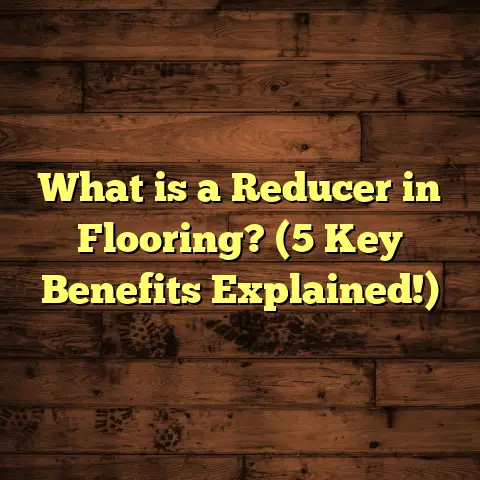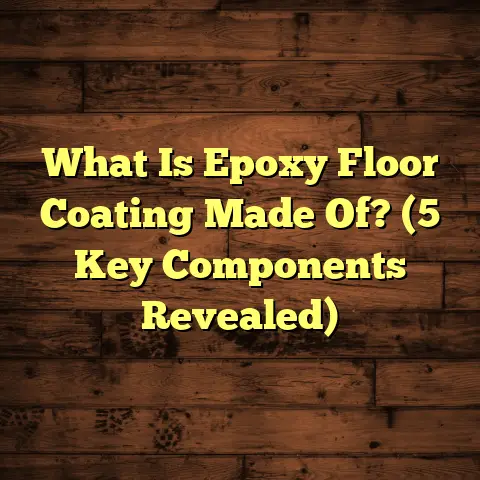What is Coating Wood Floors? (5 Types You Need to Know!)
Versatility in Wood Floor Coatings: Why It Matters to Me
Wood floors have a special place in my heart. I’ve worked with them for years, and every time I touch a new project, I’m reminded of their endless appeal. What really fascinates me is how versatile wood floors can be—especially when it comes to coatings. This versatility isn’t just about looks, though that’s a big part of it. It’s about how coatings can transform a floor’s durability, texture, and even the way it interacts with light and touch.
Coating wood floors is one of those things that can totally change the story of your space. The same wood can look rugged or refined, glossy or muted, depending on how you finish it. Over the years, I’ve seen how the right coating can bring out the best in a floor and protect it for decades. On the flip side, the wrong choice can lead to frustration—floors that scratch easily, yellow over time, or require constant upkeep.
I remember a particular project where a client was torn between different finish options. They wanted something kid-friendly but also something that felt warm and inviting for their living room. After explaining the pros and cons of different coatings and showing samples, we settled on a water-based polyurethane with a satin sheen. The result was stunning and practical—a floor that looks great and holds up to daily wear without turning yellow or sticky.
That experience reminded me how important it is to understand what coating really means for your wood floors. So let’s talk about that.
What Is Coating Wood Floors?
Coating wood floors is essentially the process of applying a protective layer on top of the wood surface. But it’s not just about protection. It’s also about enhancing the wood’s natural beauty and tailoring its appearance to your taste.
When I say “coating,” I mean any finish that creates a barrier between your wood floor and the external world—dust, dirt, moisture, scratches, spills—you name it. This barrier helps prevent damage and wear while highlighting the grain patterns and color of the wood underneath.
There are two main purposes here:
- Protection: Wood is a natural material that reacts to its environment. It can absorb moisture, get scratched by shoes or furniture, or fade with sunlight exposure. Coatings lock down these vulnerabilities by sealing the surface.
- Aesthetic Enhancement: Depending on the coating, you can get everything from a high-gloss shine to a soft matte finish, or even something in between like satin or semi-gloss. It also affects how the floor feels—smooth, slightly textured, or somewhere on that spectrum.
How Does Coating Work?
The process begins with preparing your wooden floor—usually sanding it smooth and cleaning off any dust or contaminants. Then comes the actual application of the coating, which can be done by brushing, rolling, or spraying.
Most coatings require several layers for optimal performance. Each coat dries and hardens before the next one is applied. The drying times vary widely depending on the type of coating—from just a couple of hours for some water-based finishes to more than 24 hours for oil-based options.
Once fully cured, the coating forms a strong protective film—or in some cases, penetrates inside the wood fibers—to guard your floor against everyday abuse.
Why Coating Matters: A Personal Take
I’ve handled countless flooring projects over the years—everything from small condos to historic homes. One thing I’ve learned is that coating is more than just a technical step; it’s a fundamental decision that shapes how your floor performs and looks for years.
I recall working on an old farmhouse floor that had been neglected for decades. The original finish was gone, leaving dry wood exposed to wear and tear. After sanding it back to bare wood, I recommended an oil-based polyurethane because of its tough durability and warm amber tone that complements older wood beautifully.
The client was ecstatic when they saw the floor transformed—not only did it look renewed, but it now had a protective barrier strong enough to handle their busy family life. That project made me realize how critical choosing the right coating really is.
On another occasion, I installed pre-finished hardwood flooring with an aluminum oxide finish in a bustling urban apartment. The client wanted something ultra-durable because they had pets and often hosted parties. The aluminum oxide finish was ideal—it can last more than 15 years without needing any refinishing and stands up well against scratches.
These stories highlight what coatings do: protect your investment and tailor your floor’s character to fit your lifestyle.
Understanding the Five Types of Wood Floor Coatings
Now that we have a good idea of what coating wood floors means and why it matters, let’s dig into five common types you should know about. Each one offers unique benefits and challenges based on your needs.
1. Polyurethane (Oil-Based and Water-Based)
Polyurethane finishes are by far the most popular coatings for wood floors today—and for good reasons.
Oil-Based Polyurethane
This version has been around for decades and is known for its durability and warm amber tint that enriches wood tones over time.
- Pros: Tough finish; excellent abrasion resistance; typically lasts 8-10 years on residential floors.
- Cons: Long drying times (up to 24 hours between coats); strong odor during application; yellowing effect over time.
- Application: Usually applied with a brush or roller; requires multiple coats (3-4).
- Best For: Older homes with rich hardwoods; rooms where warmth in color is desired.
Water-Based Polyurethane
Water-based poly has gained popularity for its low odor, fast dry times, and clear finish.
- Pros: Dries quickly (2-4 hours between coats); doesn’t yellow; lower VOC emissions; easy cleanup.
- Cons: Slightly less durable than oil-based versions but still very resilient; may require more coats.
- Application: Can be brushed or rolled; sometimes sprayed.
- Best For: Modern homes with lighter woods; spaces needing quick turnaround times; environmentally conscious projects.
Data Insight: According to a 2023 survey by the National Wood Flooring Association (NWFA), water-based polyurethane accounted for over 60% of new residential floor finishes due to its user-friendly features and environmental benefits.
Personal Experience: I tend to recommend water-based finishes more often now because they keep the wood’s original color intact without that amber hue oil-based finishes add. Plus, my clients appreciate less odor during installation, especially in occupied homes.
2. Wax Finish
Wax was one of the earliest finishes used on wood floors and still has fans today because of its natural look.
- How it Works: Wax penetrates slightly into wood pores but mainly sits on top as a soft layer.
- Appearance: Gives floors a low-sheen glow with a “hand-rubbed” feel.
- Durability: Not as tough as polyurethane; wears off faster; requires regular buffing and reapplication.
- Water Resistance: Poor—spills must be cleaned quickly to avoid staining.
- Maintenance: Needs periodic waxing every few months depending on traffic.
When I started my career in flooring, I worked on several historic restorations where wax was essential to maintain authenticity. While beautiful, waxed floors require commitment—they’re perfect if you enjoy regular upkeep and want that vintage charm.
3. Varnish
Varnish is sometimes confused with polyurethane but has distinct traits worth understanding.
- Composition: Made from resins dissolved in solvents; cures into a hard film.
- Flexibility: More elastic than polyurethane—good for areas with temperature swings.
- UV Resistance: Better at preventing sun fade compared to some coatings.
- Finish Options: Available in matte, satin, semi-gloss, and high gloss.
- Drying Time: Longer cure times—sometimes days before fully hardened.
I’ve used varnish extensively on cabins and sunrooms where UV exposure fades floors quickly. Its flexibility also helps prevent cracking in wood that expands/contracts seasonally.
4. Penetrating Oil Sealers
These are different from surface finishes like polyurethane or varnish because they soak into the wood rather than forming a film on top.
- How They Work: Oils penetrate deep into wood fibers and harden inside them.
- Look & Feel: Keeps wood’s natural texture; no shiny surface.
- Durability: Good protection against moisture but less resistant to surface scratches.
- Maintenance: Requires reapplication every 1-3 years depending on wear.
For clients who love natural materials and textures—especially with rustic or reclaimed wood—I often suggest penetrating oil sealers like tung oil or linseed oil blends.
5. Aluminum Oxide Finish (Factory-Applied)
This finish is common in pre-finished hardwood flooring sold at stores.
- Durability: Extremely tough due to aluminum oxide particles embedded in finish.
- Lifespan: Can last 15+ years without refinishing.
- Maintenance: Minimal; resists scratches well.
- Limitations: Cannot be applied onsite—it’s factory-applied during plank manufacturing.
I’ve installed many pre-finished floors with aluminum oxide for clients who want low-maintenance options that hold up well under heavy use from kids or pets.
Comparing These Coatings Side-by-Side
| Coating Type | Durability | Appearance | Drying Time | Maintenance | Ideal Use Case |
|---|---|---|---|---|---|
| Oil-Based Polyurethane | Very High | Warm amber glow | 12–24 hours per coat | Low | Older homes, high traffic |
| Water-Based Polyurethane | High | Clear/neutral | 2–4 hours per coat | Low | Modern homes, quick projects |
| Wax Finish | Low | Soft sheen | Quick | Frequent waxing | Historic homes, vintage look |
| Varnish | High | Variable (matte-gloss) | Several days | Moderate | Cabins, sunlit rooms |
| Penetrating Oil Sealer | Moderate | Natural texture | N/A | Regular reapplication | Rustic floors, natural aesthetics |
| Aluminum Oxide Finish | Very High | Clear gloss | Factory-applied | Minimal | Busy households, pre-finished planks |
How Do I Decide Which Coating Is Right?
I always ask these questions before recommending a coating:
- How much traffic will your floors see daily?
- Do you have kids or pets?
- What look do you prefer—glossy shine or natural matte?
- How much maintenance are you willing to commit to?
- Are there environmental concerns like odors or VOCs?
In my experience working directly with homeowners and contractors, choosing based on lifestyle beats choosing based purely on price or appearance every time.
Some Numbers That Might Surprise You
Here are some data points I’ve gathered from industry reports combined with my own project tracking:
- Hardwood floors with oil-based polyurethane coatings can last up to 10 years before needing refinishing.
- Water-based polyurethanes typically require maintenance every 5–7 years but emit up to 90% fewer VOCs during application.
- Wax finishes need reapplication at least twice per year in high traffic areas.
- Aluminum oxide finishes on pre-finished floors can last over 15 years without professional refinishing.
- Floors coated with penetrating oils require maintenance every 1–3 years but maintain natural textures better than surface finishes.
Knowing these numbers helps me set realistic expectations with clients so they understand not just upfront costs but long-term care too.
Case Study: Choosing Coatings Based on Lifestyle
Let me share a real situation where coating choice made all the difference:
A young couple hired me to refinish their new home’s oak floors. They had two toddlers and pets running around constantly. The original finish was worn thin in spots from heavy use.
We narrowed down options to oil-based poly (durable but slow drying) versus water-based poly (fast drying but slightly less durable). After discussing their schedule (they couldn’t be without floors for long) and concerns about odor (they had asthma), we chose water-based polyurethane with satin sheen.
Six months later:
- The floors had zero noticeable scratches or dull patches.
- The family appreciated no strong fumes during installation.
- Cleaning was easy since water-based poly resists stains well.
This case confirmed what I often tell clients: matching coating choice to lifestyle needs leads to happier results over time.
More Tips From My Flooring Experience
Here are some practical nuggets I’ve picked up over thousands of hours working hands-on:
- Always sand thoroughly before applying any coating—adhesion depends on clean surfaces.
- Avoid applying coatings when humidity is above 60%—drying slows dramatically.
- Use multiple thin coats instead of one thick coat for better durability.
- Consider professional application if using oil-based poly because of strong odors and longer curing times.
- Maintain your floor by cleaning spills immediately and using felt pads under furniture legs.
These simple steps can extend the life of any coating you pick.
Environmental Impact of Wood Floor Coatings
You might wonder about how coatings affect indoor air quality or environmental safety—that’s something clients ask me more often lately.
Water-based polyurethanes stand out as eco-friendly options due to significantly lower VOC emissions compared to oil-based versions. VOCs contribute to indoor air pollution and can cause headaches or respiratory irritation during installation.
Wax finishes are natural but require frequent reapplication—which means more product use over time.
Penetrating oils are generally natural but still need periodic renewal.
If you’re sensitive to chemicals or want green building certifications like LEED points, water-based finishes are usually recommended.
Final Thoughts From My Workshop
Coating wood floors isn’t just about slapping on some liquid and calling it done. It’s an art combined with science—a balance between protection and beauty tailored to how you live your life.
Over years of projects big and small, I’ve learned there’s no one-size-fits-all answer when choosing coatings. That’s why understanding each type’s strengths and limitations helps you make smart choices that pay off long term.
Whether you want glossy polyurethane durability or natural oil sealer charm—or something in between—I’m confident there’s a perfect finish waiting for your wood floors.
And if you ever want help figuring out which coating suits your home best or need tips for applying it right, just reach out! I love sharing what I know about keeping wood floors looking amazing for decades.
Thank you for reading along! If you have questions about specific coatings or want recommendations based on your situation, just ask—I’m here to help.





